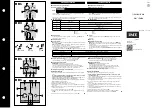
108
2.2
Current setting
,
B
.
2.3
Underload by cos
. PF.
e.g.: relay GL16
,
B
=8+4 =12 A
21
)8//
/2$'
&855(17
6(77,
1*
,
%
$
75,3&/$666
RQ
RII
56
7
W
R
21
21
,
B
=
,
N
x n
Installation and Adjustment guide
Relays C, GL, P, PF, G, BG and GEN
Adjust the current
,
B
on the corresponding dipswitches (full load current).
When setting the current take into account that the base current of the relay
always remains added to the current selected with the dipswitches in “ON”
position (to the right). The total addition is the set current
,
B
.
Overload tripping current from 1,1 x
,
B
a) For motor or generator rated currents (
,
N
) within the range of the relay, the
setting
,
B
must be equal to the
,
N
of the motor or generator.
,
B
=
,
N
b) For motor rated currents below the range of the relay, the setting
,
B
must
be equal to the rated current of the motor
,
N
multiplied by the number
of times that the conductors have been passed through the relay holes.
c) For motor or generator rated currents (
,
N
) above the range of the relay, use
three current transformers .../5 in combination with the C9, GL16, P19,
PF16-R, G17, BG17 or GEN10 according to application.
With current transformers it is always a must to pass the conductors 2
times or more through the holes of the relay.
PS relay
This adjustment is to be made according to the nominal current of the motor
,
N
indicated in its characteristics plate. The value to be set
,
B
is the same as
,
N
. The relay trips with overloads above 1,1 x IB
,
B
.
,
B
=
,
N
The cos
underload trip level is set by means of a potentiometer with
settings from 0,15 to 1,0.
Select this value taking into consideration the no-load motor cos
and
that corresponding to the estimated minimum operating load. Choose an
intermediate value between these two cos
levels and set it in the relay.
Select the underload trip delay from 5 to 45 seconds using the 3
corresponding dipswitches (trip delay).
For your guidance you can find two practical examples below.
a) A very oversized motor for its application. The cos
of the motor is 0,15
when working without load.
b) A slightly oversized motor for its application. The cos
of the motor is
0,25 when working without load.
If the above mentioned cos
values are unknown, the underload trip setting
can be made in the following way:
1. Set the underload trip delay to zero by moving the three dipswitches
to the left (trip delay).
2. Using the potentiometer (cos
setting), set the cos
value to the
minimum: 0,15.
3. Set the reset time to the minimum value using the potentiometer
(cos
reset time).
4. Start up the motor and run it with the minimum estimated load.
5. Slowly turn the cos
potentiometer clockwise until the relay trips and
the cos
LED lights up.
6. Turn the cos
potentiometer anticlockwise until the cos
is set at
approximately 30% less than the previous value (point 5).
7. Set the underload trip delay using the 3 corresponding dip switches.
Set the reset time using the adequate potentiometer.
Nominal
load
Estimated
minimum load
Approximated
cos
adjustement area
cos
No-load
Nominal
load
Estimated
minimum load
Approximated
cos
adjustement area
cos
No-load
always n ≥ 2
,
B
=
,
N
motor
x 5 x n
,
N
trafo
























